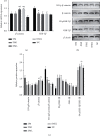Liraglutide Attenuates Hepatic Oxidative Stress, Inflammation, and Apoptosis in Streptozotocin-Induced Diabetic Mice by Modulating the Wnt/ β-Catenin Signaling Pathway
- PMID: 36756089
- PMCID: PMC9899592
- DOI: 10.1155/2023/8974960
Liraglutide Attenuates Hepatic Oxidative Stress, Inflammation, and Apoptosis in Streptozotocin-Induced Diabetic Mice by Modulating the Wnt/ β-Catenin Signaling Pathway
Abstract
Liraglutide has been extensively applied in the treatment of type 2 diabetes mellitus and also has hepatoprotective effects. However, the role of liraglutide treatment on liver injury in a mouse model of type 1 diabetes mellitus (T1DM) induced by streptozotocin (STZ) and its underlying mechanisms remain to be elucidated. In the present study, diabetes was initiated in experimental animals by single-dose intraperitoneal inoculation of STZ. Forty female C57BL/6J mice were equally assigned into five groups: diabetic group, insulin+diabetic group, liraglutide+diabetic group, insulin+liraglutide+diabetic group, and control group for eight weeks. Diabetic mice exhibited a significantly elevated blood glucose level and decreased body weight, and morphological changes of increased steatosis and apoptosis were observed in the liver compared with the control. Furthermore, a significant increase in the levels of malondialdehyde and inflammatory markers such as tumor necrosis factor-α (TNF-α), interleukin-6 (IL-6), and interleukin 1β (IL-1β) and the proapoptotic proteins caspase-3 and Bax were observed in the livers of diabetic mice, together with marked increases in antioxidants superoxide dismutase (SOD) and glutathione peroxidase (GPX) as well as antiapoptotic protein Bcl-2, all of which were significantly mitigated by treatment with liraglutide, insulin, and their combinations. Interestingly, liraglutide monotherapy showed better efficacy in ameliorating liver injury in T1DM mice than insulin monotherapy, similar to the combined drug therapy. Furthermore, the expression of Wnt/β-catenin signaling pathway-associated molecules was upregulated in the liver of mice treated with liraglutide or insulin. The results of the present study suggested that liraglutide improves T1DM-induced liver injury and may have important implications for the treatment of nonalcoholic fatty liver disease (NAFLD) in patients with T1DM.
Copyright © 2023 Jie Yu et al.
Conflict of interest statement
The authors declare no conflict of interest.
Figures





Similar articles
-
Potentials of bone marrow cells-derived from naïve or diabetic mice in autoimmune type 1 diabetes: immunomodulatory, anti-inflammatory, anti hyperglycemic, and antioxidative.Endocrine. 2024 Dec;86(3):959-979. doi: 10.1007/s12020-024-03929-7. Epub 2024 Jul 17. Endocrine. 2024. PMID: 39014283 Free PMC article.
-
Rehmannia glutinosa (Gaertn.) DC. polysaccharide ameliorates hyperglycemia, hyperlipemia and vascular inflammation in streptozotocin-induced diabetic mice.J Ethnopharmacol. 2015 Apr 22;164:229-38. doi: 10.1016/j.jep.2015.02.026. Epub 2015 Feb 17. J Ethnopharmacol. 2015. PMID: 25698243
-
Liraglutide Improves Non-Alcoholic Fatty Liver Disease In Diabetic Mice By Modulating Inflammatory Signaling Pathways.Drug Des Devel Ther. 2019 Dec 2;13:4065-4074. doi: 10.2147/DDDT.S224688. eCollection 2019. Drug Des Devel Ther. 2019. PMID: 31819375 Free PMC article.
-
Liraglutide Improves Diabetic Cardiomyopathy by Downregulation of Cardiac Inflammatory and Apoptosis Markers.Curr Drug Res Rev. 2024;16(3):289-299. doi: 10.2174/0125899775243787231103075804. Curr Drug Res Rev. 2024. PMID: 37966282 Review.
-
Mechanisms of Diabetes-Induced Liver Damage: The role of oxidative stress and inflammation.Sultan Qaboos Univ Med J. 2016 May;16(2):e132-41. doi: 10.18295/squmj.2016.16.02.002. Epub 2016 May 15. Sultan Qaboos Univ Med J. 2016. PMID: 27226903 Free PMC article. Review.
Cited by
-
Diabetic peripheral neuropathy: pathogenetic mechanisms and treatment.Front Endocrinol (Lausanne). 2024 Jan 9;14:1265372. doi: 10.3389/fendo.2023.1265372. eCollection 2023. Front Endocrinol (Lausanne). 2024. PMID: 38264279 Free PMC article. Review.
-
Unraveling the triglyceride-glucose index: a key predictor of liver fat content and the amplifying role of BMI: evidence from a large physical examination data.Front Endocrinol (Lausanne). 2025 Apr 25;16:1555300. doi: 10.3389/fendo.2025.1555300. eCollection 2025. Front Endocrinol (Lausanne). 2025. PMID: 40352458 Free PMC article.
-
Antinociceptive Behavior, Glutamine/Glutamate, and Neopterin in Early-Stage Streptozotocin-Induced Diabetic Neuropathy in Liraglutide-Treated Mice under a Standard or Enriched Environment.Int J Mol Sci. 2024 Oct 8;25(19):10786. doi: 10.3390/ijms251910786. Int J Mol Sci. 2024. PMID: 39409118 Free PMC article.
-
Liraglutide Attenuates Atorvastatin-Induced Hepatotoxicity by Restoring GLP-1R Expression and Activating Nrf2 and Autophagy Pathways in Wistar Rats.Toxics. 2025 Jul 16;13(7):594. doi: 10.3390/toxics13070594. Toxics. 2025. PMID: 40711038 Free PMC article.
-
Microglial exosome TREM2 ameliorates ferroptosis and neuroinflammation in alzheimer's disease by activating the Wnt/β-catenin signaling.Sci Rep. 2025 Jul 10;15(1):24968. doi: 10.1038/s41598-025-09563-1. Sci Rep. 2025. PMID: 40640358 Free PMC article.
References
-
- de Vries M., Westerink J., Kaasjager K., de Valk H. W. Prevalence of nonalcoholic fatty liver disease (NAFLD) in patients with type 1 diabetes mellitus: a systematic review and meta-analysis. The Journal of Clinical Endocrinology and Metabolism . 2020;105(12):3842–3853. doi: 10.1210/clinem/dgaa575. - DOI - PMC - PubMed
MeSH terms
Substances
LinkOut - more resources
Full Text Sources
Medical
Research Materials

